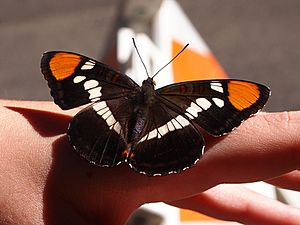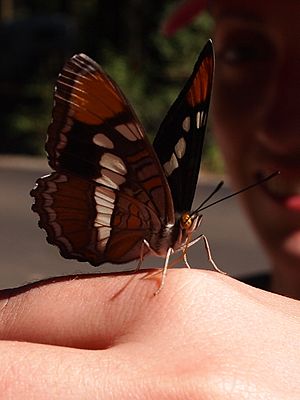California sister facts for kids
Quick facts for kids California sister |
|
|---|---|
 |
|
| Scientific classification | |
| Genus: |
Adelpha
|
| Species: |
californica
|
| Synonyms | |
|
|
The Adelpha californica, also known as the California sister, is a type of butterfly. It belongs to the family called Nymphalidae, which includes many brush-footed butterflies. These butterflies are quite common in California. You can also find them in parts of western Nevada and Oregon, and even in northern Baja California, Mexico.
California sister butterflies have dark brown to black wings on top. They have wide, creamy-white bands across both their front and back wings. Near the tips of their front wings, they have two bright orange patches. The underside of their wings is a mix of browns, blues, oranges, and whites. These butterflies don't taste good to animals that might want to eat them. Because of this, many other insects look similar to them to avoid being eaten too. This is called mimicry.
Contents
About the California Sister
How Butterflies Get Their Names
Scientists have a special way of naming and grouping all living things. This is called taxonomy. The California sister butterfly is part of a group called Adelpha, which means "sisters." This name comes from the black and white markings on their wings, which some people think look like a nun's habit.
The California sister was first described by a British scientist named Arthur Gardiner Butler in 1865. He first called it Heterochroa californica. For a while, some scientists thought it was just a type of another butterfly, Adelpha bredowii. But newer studies, looking at how the butterflies look, where they live, and their genetics, show that the California sister is its own unique species.
Where They Live
California sister butterflies live in the far western part of North America. You can find them from northern Baja California in Mexico, through most of California, and into western Nevada and western Oregon in the United States. Sometimes, they might even fly into southwestern Washington, but these are usually just visitors. They love to live in oak woodlands, which are forests filled with oak trees.
What They Look Like
The top side of a California sister's wings is a dark brown or black. They have two big orange spots near the tips of their front wings. They also have wide, creamy-white bands that cross both their front and back wings. The underside of their wings looks similar but has pretty blue bands along the edges. It also has blue and orange patterns closer to their body.
The California sister looks a lot like two other butterflies, Adelpha bredowii and Adelpha eulalia. However, they usually live in different places. A. bredowii is mostly found in southern and western Mexico. A. eulalia lives in Arizona and nearby areas, though it might sometimes be seen in southeastern California. California sisters are usually smaller than A. eulalia. They also have a second orange bar on the upper part of their back wings that A. eulalia doesn't have.
Life Cycle of the California Sister
From Egg to Adult
The life of a California sister butterfly starts as a small green egg. The female butterfly lays each egg by itself on the tips of oak leaves, usually on the top surface.
After about eleven days, a tiny larva (or caterpillar) hatches from the egg. This first caterpillar is olive green with light spots and a brown head. It builds a special perch from the middle vein of a leaf. Over the next few weeks, the caterpillar grows and sheds its skin four more times. Each time it sheds, it becomes a new "instar" and changes its look a bit. It develops horn-like bumps called scoli, which have black spines.
After about fourteen days as a caterpillar, the final instar will turn into a pupa. The pupa is pale brown or golden yellow with dark brown and metallic gold markings. It hangs from tree trunks, attached by a silky web. After about ten days, the adult butterfly, called an imago, comes out of the pupa. The whole journey from egg to adult takes about sixty-five days.
What They Eat
California sister caterpillars mostly eat the leaves of oak trees. They especially like the canyon live oak and the coast live oak. Eating these oak leaves makes the caterpillars (and later the butterflies) taste bad to animals that might want to eat them. This is why many other species have evolved to look like them – it helps them avoid predators too!
Adult California sister butterflies are often seen flying near the tops of oak trees or resting near small streams and canyons. Male butterflies often gather on moist ground, like mud puddles, to drink water. Both male and female butterflies also drink nectar from flowers, though this is not as common. They also like to drink from rotting fruit, tree sap, and even animal droppings.
Depending on the weather and how high up they live, these butterflies can have one to three generations each year. You can usually see the adult butterflies flying from March all the way through November. Sometimes, they might even survive through the winter months.
Conservation Status
The California sister butterfly is not considered to be in danger. It is very common throughout the areas where it lives.


